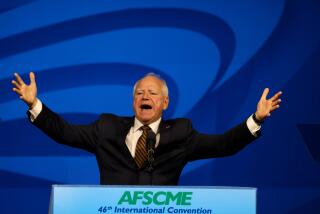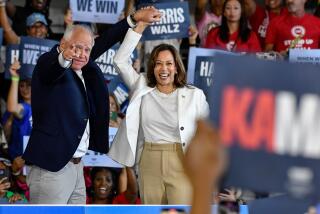AFSCME Sees Itself as ‘Union of the Future’
- Share via
When Taylor Rogers joined the American Federation of State, County and Municipal Employees (AFSCME) in Memphis 20 years ago he was a poor garbage man, earning barely a dollar an hour with no fringe benefits. Now, he makes nearly $9 an hour, has a full benefits package and was invited to Gov. Ned McWherter’s official mansion in Knoxville, Tenn., after the union helped get McWherter elected in 1986.
Most of all though, said Rogers, who now is president of the AFSCME local in Memphis and was a delegate to the union’s national convention in Los Angeles this week, his contract gives him “dignity.”
With members in 46 states and in a whole slough of occupations--it represents hospital workers, lawyers, engineers and zookeepers, among others--AFSCME is one of the most diverse unions in the nation. With 1.1 million members, it is also one of the largest--and three times bigger than it was when Rogers signed up in 1968.
Outlook Is Healthy
In an era when most unions are in well-publicized decline, AFSCME is growing and likes to call itself, in the words of President Gerald W. McEntee, “the union for America’s future.”
Whether or not that’s true, AFSCME has come a long way since its beginnings as the Wisconsin State Employees Assn. in 1936. Two years later, AFSCME won its first collective bargaining agreement with a major city--Philadelphia--after a bruising garbage worker strike led by McEntee’s father, William.
Slow, steady growth resulted in a membership of 200,000 by 1960. But growth really took off in the 1960s and 1970s as public employees gained sweeping collective bargaining rights. Membership reached 1 million in 1978.
Predictions Differ
Some academicians, including economist Leo Troy of Rutgers University, contend that public employee organizing has peaked and suggested that AFSCME may not grow much more. But others, such as David Lewin of the Columbia University School of Business, said that “there is some fertile organizing ground for AFSCME.”
Indeed, the union recently won a highly visible election to represent 3,400 clerical and technical workers at Harvard University. Harvard has filed objections to the union’s conduct during the election with the National Labor Relations Board, but Kris Rondeau, the chief organizer in the campaign, said she is confident that the union will sign a collective bargaining agreement with the prestigious university. “We’re not going away,” she said.
Meanwhile, the union is also engaged in a battle with the Laborers International Union to win the right to represent 7,300 public employees in Alaska.
Work Draws Praise
Ralph Whitehead, a University of Massachusetts professor who coined the term “new-collar worker” to describe the burgeoning group of employees whose jobs are a hybrid of white- and blue-collar skills, has said that AFSCME has done the best job of any union of appealing to these workers.
New-collar workers often are skeptical of unions, but AFSCME has positioned itself as a leading advocate for issues of importance to such employees, including pay equity for women, affordable child care, career mobility and safety in the automated office.
AFSCME has utilized both old-style one-on-one organizing and new era labor techniques such as polling and television advertising in its organizing campaigns. Some of those campaigns have been very expensive. For example, AFSCME spent nearly $9 million while garnering the right to represent 38,000 public employees in Ohio during a highly competitive campaign with several other unions.
Mostly Scandal-Free
Despite its expenditures of large amounts of cash in some campaigns, AFSCME generally has been free from scandal. However, this spring the Philadelphia Inquirer reported that the head of the union’s Philadelphia district council--Earl Stout--had used the union presidency to enrich himself, his family and his friends.
The union formally reprimanded Stout three times for violating union bylaws. In May, reform candidate James Sutton toppled Stout in an election for the district presidency.
AFSCME also has gained political visibility. The union took a leading role in the successful campaign to persuade the Senate to reject the Supreme Court nomination of Robert H. Bork. The union commissioned a $40,000 nationwide poll in an attempt to determine Bork’s vulnerabilities and AFSCME public relations director Philip Sparks helped fashion anti-Bork strategy.
Think Tank Financed
The union has also financed a liberal Washington think tank called the Economic Policy Institute in an attempt to reshape the nation’s economic and political agenda in the post-Reagan years.
There will be more delegates at the Democratic convention in Atlanta in July from AFSCME than from any other AFL-CIO union. Both Michael Dukakis, the all-but-certain Democratic nominee, and rival Jesse Jackson spoke at the convention this week.
On the union’s immediate agenda, according to McEntee, are the passage of collective bargaining rights for public employees in those states that still deny them, and elevating the wages of low-paid health care workers. AFSCME’s research director, Linda Lampkin, also said the union must fight the growing tendency of government to contract with private companies for public services, a trend that threatens the union’s continued growth.
For example, AFSCME now is battling to retain 1,800 sanitation jobs in Philadelphia, scene of the union’s first major victory 50 years ago.
“We know the challenges never end,” McEntee said.
More to Read
Sign up for Essential California
The most important California stories and recommendations in your inbox every morning.
You may occasionally receive promotional content from the Los Angeles Times.













